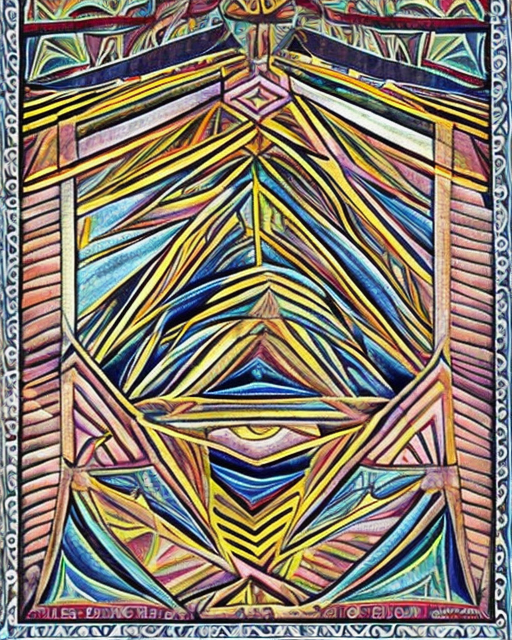Sacred Geometric Art
Sacred geometric art holds significant spiritual purposes and is deeply rooted in various ancient and esoteric traditions. Here are some of the spiritual purposes and meanings behind sacred geometric art:
- Symbolic Representation: Sacred geometric art represents fundamental universal principles and the interconnectedness of all things. It visually conveys complex spiritual concepts in a simple and profound manner.
- Harmony and Balance: The use of precise geometric shapes in art promotes a sense of harmony, balance, and order in the viewer. It is believed to resonate with the inherent structure of the universe.
- Meditative Focus: Gazing at or meditating on sacred geometric art can lead to a meditative state, where the mind becomes calm, centered, and attuned to higher consciousness.
- Energetic Alignment: Some believe that sacred geometric symbols have inherent energetic properties, and being in the presence of such art can help align and balance the viewer’s energy.
- Connection to Higher Realms: Sacred geometry is thought to be a bridge between the physical and spiritual dimensions, and its art can assist individuals in connecting with higher realms and universal wisdom.
- Activation of Consciousness: By contemplating sacred geometric art, individuals may activate latent aspects of their consciousness, leading to expanded awareness and spiritual growth.
- Enhanced Intuition: Sacred geometric symbols are believed to awaken intuitive faculties and facilitate access to inner knowledge and wisdom.
- Protection and Healing: Some sacred geometric patterns, like the Flower of Life or Sri Yantra, are considered to have protective and healing qualities when incorporated into art or sacred spaces.
- Aid in Visualization: Sacred geometric art can serve as a tool for visualization exercises, aiding individuals in manifesting their intentions and desires.
- Sacred Space Enhancement: Placing sacred geometric art in homes or sacred spaces can elevate the energetic atmosphere, creating an environment conducive to spiritual practices and inner exploration.
- Transformation and Awakening: Viewing or working with sacred geometric art can trigger transformative experiences and spiritual awakenings, leading to a deeper understanding of the self and the universe.
- Resonance with Cosmic Order: Sacred geometric art reflects the mathematical and geometric patterns found throughout nature, aligning the viewer with the inherent order and beauty of the cosmos.
Ultimately, the spiritual purposes of sacred geometric art can vary depending on personal beliefs and interpretations. Its profound symbolism and visual impact continue to captivate spiritual seekers, artists, and those on a journey of self-discovery and enlightenment.
Here are some examples of famous geometric art pieces and artists known for their contributions to this style:
- Piet Mondrian: Mondrian is famous for his abstract paintings composed of rectangles and primary colors. One of his iconic works is “Composition II in Red, Blue, and Yellow,” which showcases his distinctive use of geometric elements.
- Bridget Riley: Riley is associated with Op Art, a movement that uses optical illusions to create dynamic visual effects. Her work “Movement in Squares” features a series of black and white squares that create a sense of movement and depth.
- Kazimir Malevich: Malevich was a pioneer of abstract art and is known for his “Black Square” painting, which is often considered one of the earliest examples of geometric abstraction. This work emphasizes the simplicity of shape and color.
- Victor Vasarely: Vasarely is often regarded as the father of Op Art. His work “Zebra” is a prime example, featuring a repeating pattern of black and white stripes that create a sense of optical movement.
- Sol LeWitt: LeWitt is known for his minimalist and conceptual geometric art. His “Wall Drawings” are a series of installations that provide instructions for creating geometric designs directly on the wall, emphasizing the importance of the concept over the artist’s hand.
- Anni Albers: Anni Albers was a textile artist and designer who incorporated geometric patterns and structures into her woven artworks. Her pieces often combine intricate geometric shapes with vibrant colors.
- Frank Stella: Stella’s work is associated with Minimalism and Color Field painting. His “Die Fahne Hoch!” is an example of his use of simple geometric forms and bold colors in a three-dimensional composition.
- Carlos Cruz-Diez: Cruz-Diez was a Venezuelan artist known for his exploration of color and perception. His “Chromosaturation” installations create immersive experiences by bathing rooms in different colored lights, allowing viewers to experience the effects of color interactions.
- Yaacov Agam: Agam is known for his kinetic art, which often involves transforming geometric patterns into dynamic and changeable artworks. His piece “Double Metamorphosis III” changes appearance as the viewer moves around it.
- Ellsworth Kelly: Kelly’s work often features simple geometric shapes in bold colors. His piece “Spectrum Colors Arranged by Chance IV” displays a grid of colored squares that create a harmonious visual rhythm.
These examples represent just a fraction of the wide range of geometric art styles and artists. Geometric art continues to evolve and inspire artists in various ways, with contemporary artists incorporating digital tools and new materials to push the boundaries of this style.

